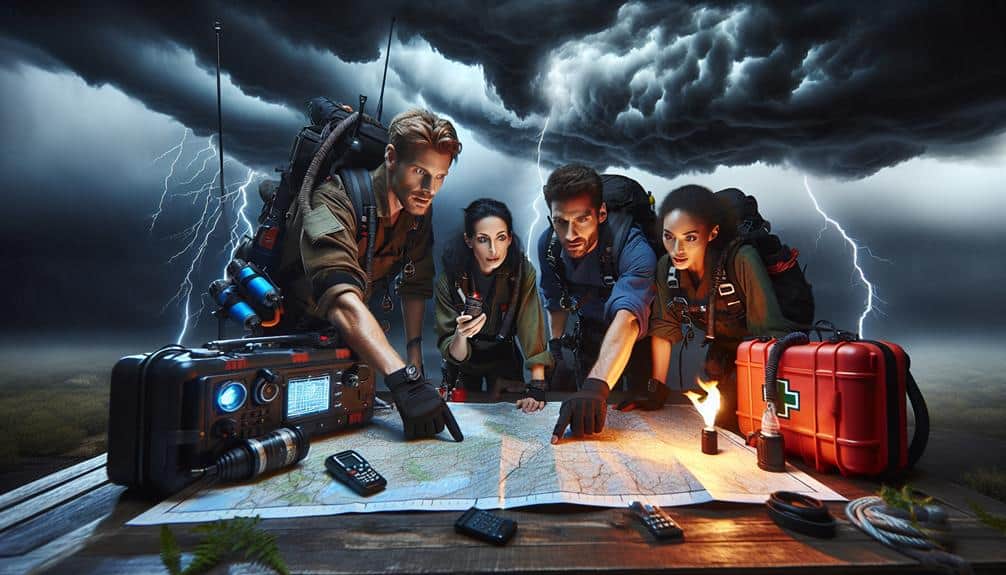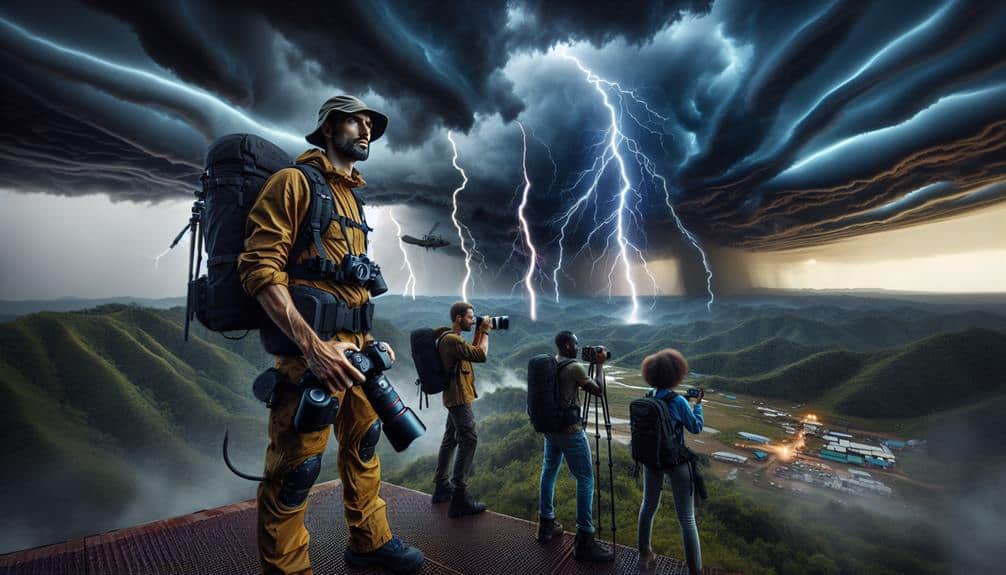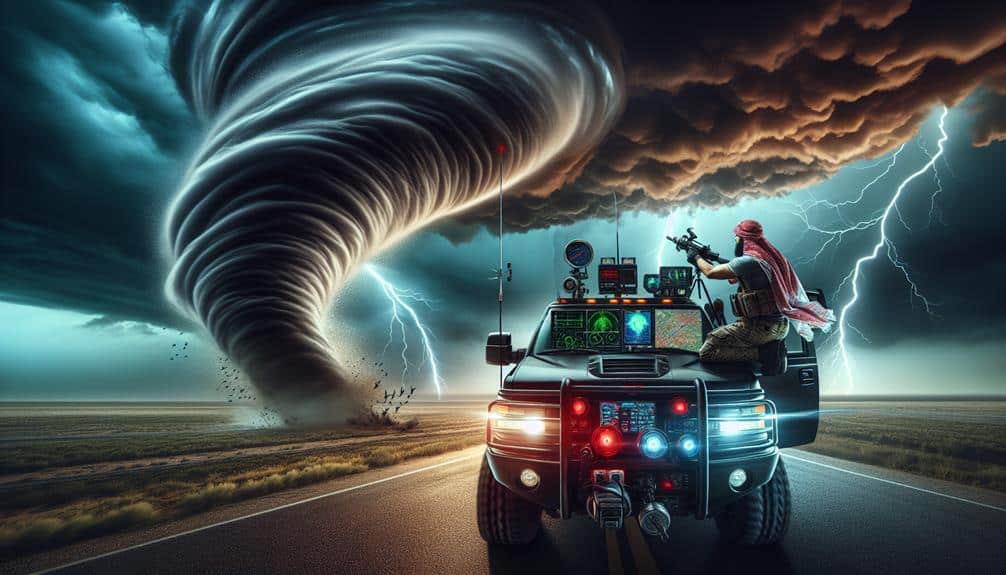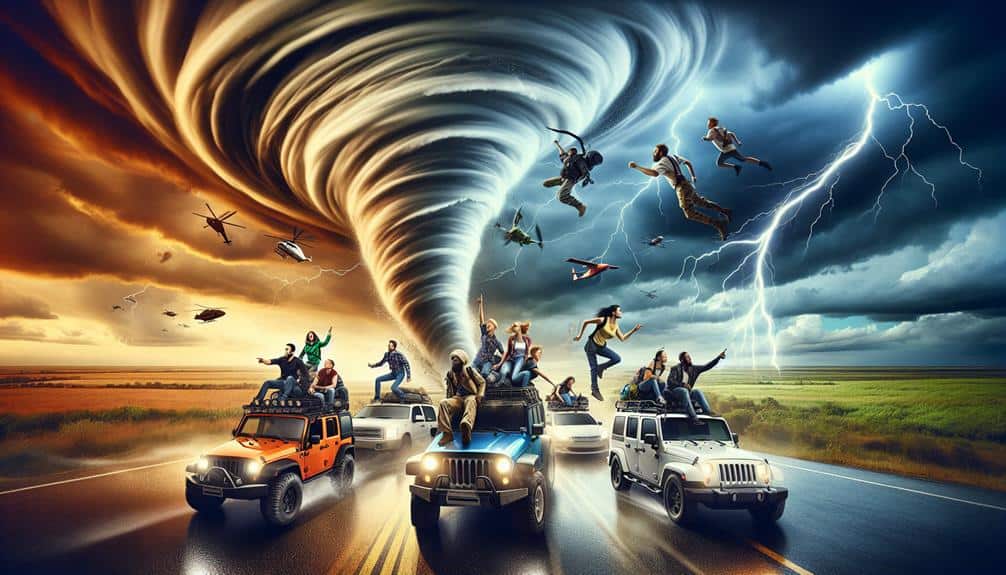We prioritize a data-driven approach to storm chasing risk assessments by first understanding atmospheric conditions using Doppler radar and satellite imagery. Weekly maintenance and calibration of our equipment guarantee reliability in the field. Analyzing terrain aids in precise route planning and safety precautions. Evaluating our team's skills through continuous training enhances response capabilities. We plan emergency protocols with regular drills and strong communication systems. Real-time monitoring via credible sources minimizes misinformation. By integrating these strategies, we maintain accurate decision-making and ensure thorough risk assessments, which are critical for effective storm chasing operations. Stay with us to learn how these strategies interconnect.
Key Points
- Understand atmospheric conditions using Doppler radar and satellite imagery for accurate storm formation predictions.
- Ensure weekly maintenance and calibration of equipment to maintain reliability during storm chases.
- Plan routes considering terrain challenges and equip vehicles with necessary supplies and communication systems.
- Train team members in meteorology, navigation, and emergency response for effective and safe storm chasing.
Understand Weather Patterns
To effectively assess the risks associated with storm chasing, we must analyze and interpret various weather patterns meticulously. Accurate weather forecasting hinges on our ability to understand atmospheric conditions, which include temperature gradients, humidity levels, and wind speeds. These elements interact dynamically, creating the scenarios we aim to monitor.
We rely on data from Doppler radar, satellite imagery, and weather stations to predict potential storm formations. By examining the atmospheric conditions, we can identify key indicators such as supercell development or the presence of a mesocyclone. Monitoring these conditions in real-time allows us to anticipate the likelihood of severe weather events like tornadoes or hailstorms.
This analytical approach requires us to interpret the data with precision. For instance, a significant drop in atmospheric pressure can signal the onset of severe weather. Similarly, shear profiles and CAPE (Convective Available Potential Energy) values provide insights into storm intensity and potential risks.
Evaluate Equipment Reliability
Maintaining the reliability of our equipment is crucial in accurately capturing and interpreting the atmospheric data necessary for storm chasing. Without dependable tools, our capacity for effective storm tracking is compromised, leading to increased risk and potential data inaccuracies. Therefore, we must incorporate rigorous reliability checks into our routine.
Weekly equipment maintenance is essential. By systematically examining instruments like anemometers, barometers, and Doppler radar units, we can ensure they're functioning at their best. This process involves calibrating sensors, inspecting for physical damage, and updating software to the latest versions. A minor fault or outdated system could skew data interpretation, adversely affecting our risk assessment.
Reliability checks extend beyond routine maintenance. Field tests under controlled conditions simulate storm scenarios, allowing us to verify that all systems operate seamlessly in real-world environments. Collecting baseline data during these tests establishes a reference point for future storm tracking, ensuring consistency and reliability.
During storm chasing, we continuously monitor equipment performance, noting any discrepancies or malfunctions. Immediate troubleshooting mitigates potential data loss and enhances safety. By prioritizing equipment reliability, we maintain the freedom to chase storms confidently, knowing our data is accurate and our risk assessment is sound.
Analyze Terrain Challenges
Traversing varied terrain presents significant challenges that can hinder our storm chasing efforts and compromise data accuracy. To mitigate these issues, we need to carefully analyze the terrain we'll encounter. The topographical variety, from flat plains to mountainous regions, requires us to adopt different safety precautions and route planning strategies.
Firstly, our route planning must account for road conditions and accessibility. Some rural areas may have unpaved roads that become impassable during heavy rainfall. Using real-time GPS data and pre-trip scouting can help us avoid these pitfalls.
- Road Conditions: Evaluate the state of roads to guarantee our vehicles can handle the terrain, especially under adverse weather conditions.
- Elevation: Monitor elevation changes that could impact visibility and vehicle performance.
Safety precautions are essential. We should equip our vehicles with emergency kits, including first aid supplies, water, and non-perishable food items. Additionally, maintaining a reliable communication system is vital for coordinating with team members and emergency services.
Assess Team Experience
Given the high-risk nature of storm chasing, we must thoroughly evaluate our team's experience and skill levels to guarantee safety and data collection at its best.
First, we should conduct a detailed evaluation of each member's prior storm chasing encounters. This involves quantifying the number of chases participated in, types of storms encountered, and specific roles undertaken. Objective metrics like successful data retrieval rates and incident-free chases are invaluable.
Understanding team dynamics is essential. We need to observe how effectively members communicate under stress and collaborate in real-time scenarios. This can be simulated through high-fidelity training exercises replicating storm conditions. These drills not only reveal gaps in coordination but also provide opportunities for targeted skill development.
We should also emphasize specialized training. Meteorological analysis, navigation proficiency, and emergency response skills must be continuously sharpened. By setting up regular workshops and certifications, we guarantee our team remains at the cutting edge of storm chasing techniques.
Ultimately, our analytical approach to evaluating team experience allows us to capitalize on each member's strengths while addressing weaknesses. Through this meticulous evaluation, we can operate with both freedom and precision, minimizing risk and maximizing our mission's success.
Plan Emergency Protocols

To effectively mitigate risks during storm chases, we'll establish thorough emergency protocols grounded in empirical data and best practices. Our primary goal is to make sure that every team member knows precisely what to do in any given situation, minimizing chaos and maximizing efficiency.
First, we'll carry out regular emergency drills. These drills will simulate various scenarios, from vehicle breakdowns to sudden tornado formations. By practicing these drills, we can identify weaknesses in our emergency protocols and refine them accordingly.
Additionally, we'll create strong communication protocols. Reliable communication is essential for coordinating actions and relaying crucial information. Each team member should have a designated communication device, and we'll standardize protocols for when and how to use them. This guarantees that everyone remains informed and can act swiftly.
Monitor Real-Time Updates
We'll enhance our risk assessment by integrating weather radar analysis and real-time social media alerts. Continuous monitoring of these data streams will enable us to make informed decisions and adjust our strategies promptly.
Weather Radar Analysis
Weather radar analysis allows us to monitor real-time updates, providing critical data on storm development and movement. Through radar interpretation and storm tracking, we can anticipate storm behavior and make informed decisions.
Doppler technology enhances our ability to detect precipitation, offering insights into storm intensity and structure. By analyzing radar data, we can identify rotation within thunderstorms, improving our ability to predict tornado formation.
Our approach to radar analysis includes several core practices:
- Continuous Monitoring: We utilize radar data to track storm progression, ensuring we're aware of any sudden changes in storm intensity or direction.
- Advanced Doppler Technology: Doppler radar allows us to measure wind velocities within storms, providing detailed information on the storm's internal dynamics and potential for severe weather.
Social Media Alerts
Utilizing social media alerts allows us to monitor real-time updates, providing immediate and localized information on storm developments and public safety concerns. In our risk assessment strategy, social media serves as a vital tool for gathering data from diverse sources, including local residents, emergency services, and storm chasers. This influx of information can greatly enhance our situational awareness.
However, we must address two primary issues: social media credibility and the risk factors associated with information overload. Not all data sources are reliable, and misinformation can lead to incorrect assessments and increased danger. To mitigate this, we need a strong verification process. Cross-referencing social media updates with official meteorological data and other credible sources ensures we only act on verified information. This method minimizes the chance of falling prey to erroneous reports and enhances our decision-making accuracy.
Moreover, managing information overload is crucial. The sheer volume of real-time updates can overwhelm even the most seasoned storm chasers. Effective filtering techniques, such as using algorithms to prioritize high-credibility sources, help us focus on the most relevant data. By streamlining our information intake, we maintain clarity and precision in our risk assessments.
Frequently Asked Questions
What Insurance Options Are Available for Storm Chasers?
We've analyzed the available insurance options for storm chasers. Coverage options vary, with specific coverage limits, policy exclusions, and deductible amounts. It's important to examine policies analytically to make sure they meet our risk tolerance and freedom goals.
How Do You Secure Funding for Storm Chasing Expeditions?
Securing funding for storm chasing expeditions necessitates robust funding strategies. We identify sponsorship opportunities, execute meticulous budget planning, and host targeted fundraising events. This analytical approach guarantees financial freedom to pursue our meteorological adventures.
What Are the Legal Requirements for Storm Chasing in Different Regions?
We must comprehend the regulatory compliance and licensing requirements for each region. Different areas have varying laws, so we need to analyze local data and consult legal experts to make sure we're operating within the legal framework.
How Do You Handle Media Interactions During a Storm Chase?
We prioritize media management and public relations during storm chases by designating a spokesperson, utilizing real-time data to provide accurate updates, and maintaining professional demeanor to guarantee clear, factual communication while respecting our team's operational freedom.
What Mental Health Resources Are Available for Storm Chasers?
We've got a million mental health support resources at our disposal. We rely on data-driven coping strategies and stress management techniques to stay resilient. Access to counselors and peer support networks guarantees we maintain our mental well-being.


